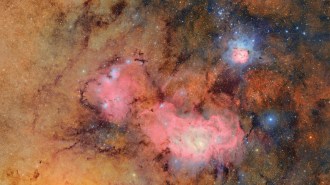A startling claim that the cosmos existed before the Big Bang doesn’t appear to be supported by detailed analyses, three independent teams of scientists have concluded.
The teams, which recently posted their findings at arXiv.org, were responding to a widely publicized report that cosmic microwave background — the glow left over from the explosive start of the universe believed to have occurred 13.7 billion years ago — contains echoes of previous cycles of cosmic birth and death (SN: 12/18/10, p. 10).
All three teams found that Roger Penrose of Oxford University in England and Vahe Gurzadyan of the Yerevan Physics Institute and Yerevan State University in Armenia incorrectly ascribed patterns found in the microwave background to bursts of energy generated in an era before the Big Bang. Penrose’s and Gurzadyan’s interpretation is based on a flawed analysis of maps of tiny temperature variations in the otherwise smooth microwave background, asserts Amir Hajian of the Canadian Institute of Theoretical Astrophysics in Toronto, who posted his analysis on December 9.
According to Hajian, Penrose and Gurzadyan failed to take into account that each small patch in a map of the temperature of the microwave background — a snapshot of the infant universe — is correlated with the temperature of adjacent patches. Such correlations provide the blueprint for the tapestry of galaxies, including the Milky Way, found in the universe today.
Adam Moss and his colleagues at the University of British Columbia in Vancouver arrived at a similar conclusion in a study posted December 7. “Gurzadyan and Penrose have not found evidence for pre–Big Bang phenomena, but have simply rediscovered that the cosmic microwave background contains structure,” the team notes.
Ingunn Wehus and Hans Eriksen of the University of Oslo in Norway concur in another study posted December 7.
The three teams agree that the circular patterns do exist but are entirely consistent with the leading model for the birth of the universe, known as inflation, and do not require an alternative, pre–Big Bang theory. According to inflation, the universe began as a subatomic entity that ballooned in size during the first tiny fraction of a second of its existence.
“The reason that Penrose and Gurzadyan believe that their result is significant is that they are comparing the [microwave background] observations with the wrong theoretical model,” says cosmologist David Spergel of Princeton University. “If an advanced undergraduate made this mistake in my class on a problem set,” he adds, “they would get a failing grade for the problem.”
In a follow-up report posted at arXiv.org on December 8, Penrose and Gurzadyan argue that their simulations of the microwave background provide a better test than previous studies of whether the circles can easily be produced by the standard theory of cosmology. They also note that the circles of low-temperature variation are bunched together rather than randomly distributed, a property that cannot be explained by inflation but fits with the notion that the universe has undergone multiple cycles, each kicked off with a separate Big Bang.
That would be true, agrees Hajian, if those circles were statistically meaningful. But given what he considers a flawed analysis, they are not, he declares.
Says cosmologist Gary Hinshaw of NASA’s Goddard Space Flight Center in Greenbelt, Md.: “Until there is a reason to doubt that circles of low variance are anything more than a chance by-product of [the leading model of cosmology], there is no compelling reason to believe the claims” of Penrose and Gurzadyan.







